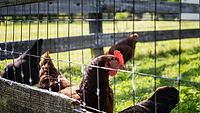Campylobacter More Prevalent on Backyard Poultry Farms, but AMR Much Higher on Commercial Farms

Image credit: cottonbro studio via Pexels
A recent study conducted by researchers at NC State University has found a significantly higher prevalence of Campylobacter on backyard poultry farms than on commercial poultry farms. The project was led by Jessica L. Parzygnat, Ph.D., within the College of Veterinary Medicine.
The findings follow those of a similar study, also led by Dr. Parzygnat, which were published in May of this year, and contrast the more recent study’s findings about Campylobacter. The research published in May 2024 focused on Salmonella rather than Campylobacter, and suggests that Salmonella is more prevalent on commercial farms than backyard operations.
Despite their earlier findings about Salmonella, in the present study, the NC State researchers discovered a higher prevalence of Campylobacter in samples from backyard farms (21.9 percent) compared to commercial farms (12.2 percent).
Samples were collected from ten backyard and ten integrated commercial broiler farms, and comprised bird fecal, soil, litter/compost, and feeder/water samples. Sampling was conducted at ten, 31, and 52 days.
The researchers characterized most of the isolates from both types of farms as C. jejuni (70.8 percent), and the remainder as C. coli (29.2 percent). A high proportion of isolates with antimicrobial resistance (AMR) to important antimicrobials was found; specifically, 40.2 percent of isolates showed phenotypic resistance to ciprofloxacin, and 46.6 percent showed resistance to tetracycline.
A higher proportion of resistance was found in C. jejuni isolates and in isolates from commercial poultry farms. For example, among isolates from backyard farms, 27.3 percent were resistant to ciprofloxacin and nalidixic acid, while 22.7 percent were resistant to tetracycline. This is in comparison to the rates seen on commercial farms, which were 63.2 percent resistance to ciprofloxacin and nalidixic acid, and 89.5 percent resistance to tetracycline.
Looking for a reprint of this article?
From high-res PDFs to custom plaques, order your copy today!






